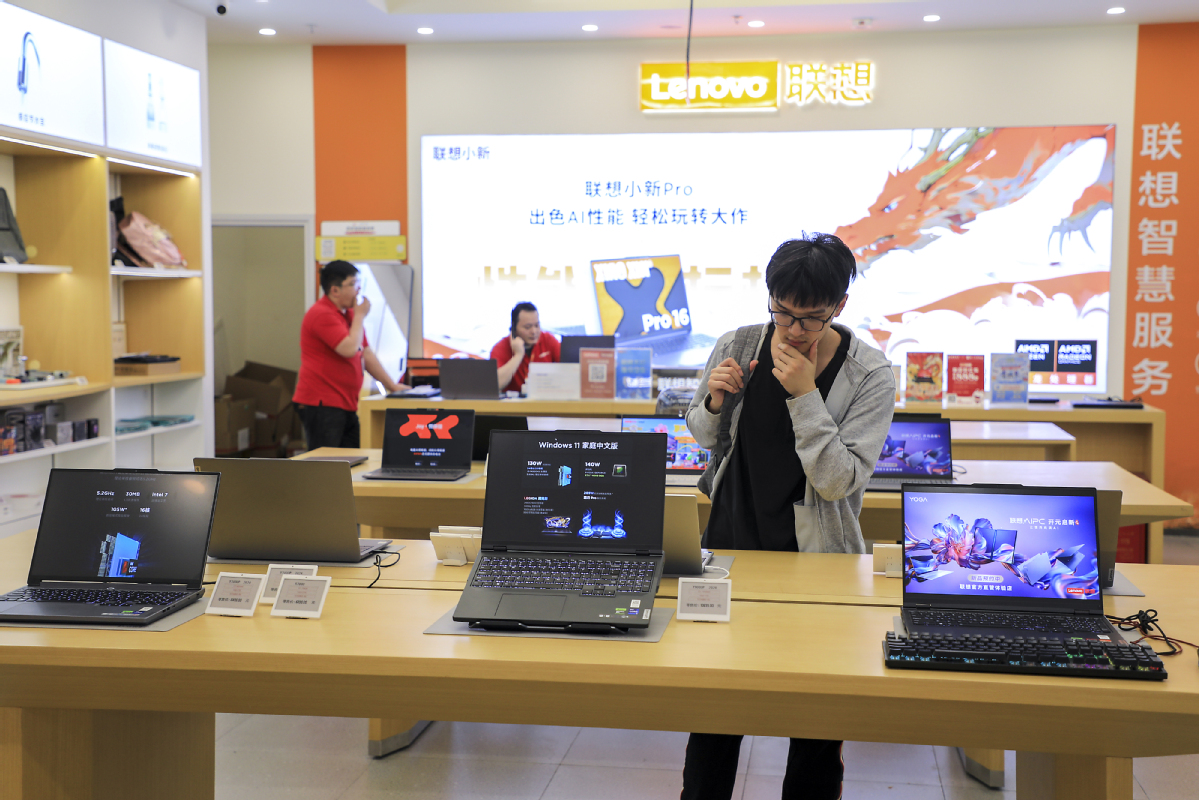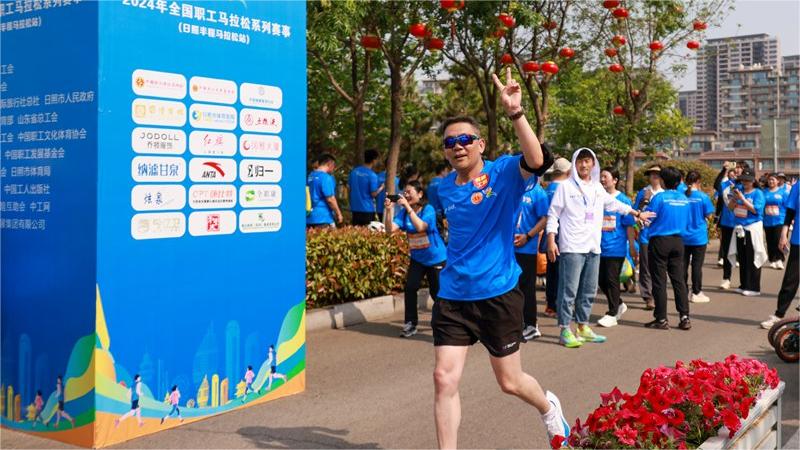Consumer electronics sales looking up

A consumer checks out Lenovo's laptop range at a mall in Shanghai on May 3. [Photo/China Daily]
After enduring nearly two years of a "winter slump", the Chinese consumer electronics market is showing signs of recovery, with the growing popularity of artificial intelligence and foldable smartphones expected to provide a further boost to sales, company executives and experts said.
The forecast comes as Chinese tech companies are scrambling to roll out new AI hardware products — including AI PCs and AI smartphones among others — to stimulate consumer enthusiasm. The new launches, coupled with the arrival of a product replacement cycle, could inject new vitality for the market to draw a steeper growth trajectory, they added.
A case in point is the overwhelming enthusiasm consumers are showing for Huawei's latest Pura 70 series smartphones. Huawei's retail stores are crowded with consumers eager to try the series' new handsets.
Ma Min, an IT programmer in Shanghai, said: "I could not buy a Huawei Mate 60 series smartphone unveiled in September because these always seemed to be in short supply. I really want to be among the first to buy a phone in the Pura 70 series, which is one of the two most iconic flagship smartphone series from Huawei."
Ming-Chi Kuo, an analyst at TF International Securities, said that the Pura 70 series, featuring Huawei's self-developed HarmonyOS 4.2 operating system and its in-house large language model to support more AI functions — such as automatically deleting unwanted objects in photos — is expected to see more significant sales growth this year than the P60 series in 2023.
If demand is strong, total shipments of Pura 70 smartphones from factories to retailers are expected to reach 13 to 15 million units. Even if demand slows, total shipments are expected to reach 10 to 12 million units, Kuo said.
That is in line with the broader picture in China's consumer electronics industry.
The Ministry of Industry and Information Technology, China's top industry regulator, said phone production volume in the country reached 374 million units in the first quarter, representing a 13.6 percent year-on-year increase. Additionally, integrated circuit production surged by 40 percent, totaling 98.1 billion units.
"China's electronic information manufacturing industry saw steady production growth, sustained export recovery, continued improvement in efficiency, and maintained high investment growth rates," the ministry said.
Market research firm Counterpoint said smartphone sales in China grew 1.5 percent year-on-year in the first quarter, marking the second consecutive quarter of positive year-on-year growth.
Ethan Qi, associate director at Counterpoint, said, "Momentum seems to be building on a recovery as China's smartphone sales continued their growth trajectory and grew 4.6 percent quarter-on-quarter from January to March."
Agreed another international market research company, International Data Corp, which said the continued recovery of market demand helped the Chinese smartphone market maintain rebound momentum at the end of last year, with performance better than expected.
Among them, the Android market grew by 9.3 percent year-on-year in the first quarter, while the iOS market faced greater competitive pressure, which fell by 6.6 percent during the same period. Thanks to the application of AI large language models and foldable screens, Android smartphones have gained differentiated advantages amid the competition with iPhones in the high-end market, IDC added.
Chinese tech company Vivo, for instance, has unveiled its latest foldable smartphone, the X Fold 3 Pro, which is the world's lightest foldable phone, opening like a book in a competitive market.
The move comes as size and weight have been drawbacks for book-style foldable phones' pursuit to enter the mainstream, and makers have increasingly released thinner and lighter foldable devices by using innovative materials and hinges.
Weighing just 219 grams, Vivo's X Fold 3 Pro is lighter than Chinese brand Honor's Magic V2, the previous record holder at 231 grams.
Vivo, which captured the top spot in China by smartphone sales in the first quarter according to data from market analyst firm Canalys, said the new phone uses second-generation silicon materials and a lightweight carbon fiber hinge.
Huang Tao, vice-president of product at Vivo, said the X Fold 3 Pro series marks the maturity of foldable screen technology and experience, which will help foldable smartphones enter the mass market.
Vivo has also inked a new partnership with Zeiss Group, a German optical systems and optoelectronics manufacturer, to expand their partnership so as to push the boundaries of mobile imaging technology.
The expanded collaboration will not only focus on traditional imaging and classic optics, but also delve into computational optics and health imaging.
Vivo said its long-term investment in imaging technology has been substantial, with over 2,000 personnel and billions of yuan in research and development funds dedicated to this field. The company has filed over 7,000 patents and developed numerous popular imaging features.
Eyeing the opportunity for AI PCs, Lenovo Group Ltd, the world's largest personal computer maker, is partnering with US chip giants such as Intel Corp and Qualcomm Inc to develop AI PCs, or computers with on-device AI, in order to address the growing demand for smarter productivity tools.
Lenovo said AI PCs can automatically create artwork presentations and synthesize knowledge based on stored documents. They suit a wide range of users, from primary school students to scientists working in Antarctica.
Yang Yuanqing, chairman of Lenovo, said the transition of AI from technological breakthroughs to practical applications marks the beginning of the second half of AI's development.
Yang said it is highly important to accumulate user feedback and continuously improve AI technology through real-world applications.
He highlighted the demanding computational requirements for AI-powered PCs, and envisions a future where every individual possesses a personal smart entity that can seamlessly integrate into PCs or smartphones.
Canalys expects about 48 million AI-capable PCs to be shipped worldwide this year, representing 18 percent of total PC sales, and the figure will top 100 million units in 2025 to account for 40 percent of total PC sales.
Lenovo's newly launched AI PCs are embedded with its in-house large language model, which can interact naturally with users, enhancing work, study and lifestyle experiences.
Leveraging local user data, AI PCs continuously improve their understanding and offer precise, personalized services, Lenovo said.
The PC industry is entering an exciting moment, said Cristiano Amon, CEO and president of Qualcomm.
Amon added that he looks forward to working with industry leaders like Lenovo to innovate and jointly build the next generation of AI PCs, bringing intelligent personalized experiences to users.
He said the world is witnessing unprecedented innovation and application of generative AI at an accelerated pace, but the development is still in its early stages.
So far, much of the development of generative AI has been concentrated in the cloud, which will continue to play an essential role. However, generative AI is rapidly evolving and will soon run directly on devices, spanning smartphones and next-generation PCs to more devices such as automobiles, Amon said.
Pat Gelsinger, CEO of Intel, said Lenovo and Intel's collaboration aims to deliver AI-enhanced PC experiences and foster a vibrant AI ecosystem in China, contributing to the global AI landscape.
Gelsinger also emphasized the transformative role of computing technology, and expected AI-driven systems to become integral to daily life, assisting in both mental and physical tasks.
Photos
Related Stories
- China, U.S. companies partner up on consumer electronics show
- CES 2024 kicks off in U.S. Las Vegas
- Chinese TV brands showcase latest display innovations at CES 2024
- China's ultra-high-definition video industry tops 3 trln yuan
- Used luxury goods hot online
- Outbound travel boom mirrors China's consumption vibrancy
Copyright © 2024 People's Daily Online. All Rights Reserved.









